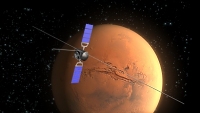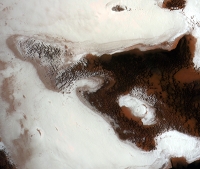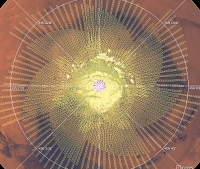MARSIS completes measurement campaign over Martian North Pole
14 December 2011
The Mars Advanced Radar for Subsurface and Ionosphere Sounding (MARSIS) instrument on board Mars Express has recently completed a subsurface sounding campaign over the planet's North Pole. The campaign was interrupted by the suspension of science observations several times between August and October due to safe modes and to anomalies in the operation of the spacecraft's Solid-State Mass Memory (SSMM) system. As MARSIS best observes in the dark, which for the North Pole only occurs every few years, it was among the first instruments to resume observations once a partial work-around for the problems had been implemented.The primary objective of MARSIS is to map the distribution of water and ice in the upper layers of the Martian subsurface. Using techniques similar to oil prospecting on Earth, the instrument analyses the reflection of radio waves down to a few kilometres in the subsurface; it is able to distinguish between dry, frozen and wet soil.
The polar regions of Mars are of particular interest because climate variations affect the quantities of water ice and dust found in the polar deposits.
The North Pole measurement campaign lasted from June to November 2011, taking place during orbits 9500 to
 |
|
Mars Express in orbit around Mars with the MARSIS antennas unfurled. Credit: ESA. |
The presence of an ionosphere also impacts the MARSIS measurements with MARSIS signals being disturbed or even completely attenuated when free electrons are present in the Martian atmosphere. There is always an ionosphere on the dayside of the planet, created by solar ultraviolet photons and energetic particles interacting with the thin atmosphere. It is, therefore, greatly preferably to observe on the nightside, where, in principle, there is no ionosphere. In practice, during periods of high solar activity an active ionosphere can be present on the nightside as well.
The careful scheduling of MARSIS measurement campaigns for polar observations is crucial to their success. Mars Express has an elliptical polar orbit, so it passes over the polar caps during every orbit; however, the altitude of the spacecraft over the poles varies as the orbit pericentre drifts with time. In the period from June to November, the spacecraft flew over the North Pole at very low altitudes – less than 1000 kilometres. Having the spacecraft in a low orbit over the target area is a requirement for operating the radar; no signal would be received at higher altitudes.
"This campaign to investigate the subsurface of Mars's North Pole is one of the highlights of the extended Mars Express mission," notes Olivier Witasse, Mars Express Project Scientist at ESA. "Despite the temporary suspension of operations during the campaign we have been able, with the excellent support of our colleagues in spacecraft operations, to complete this campaign as expected. The data that were acquired are now being analysed by the MARSIS team and we are eagerly anticipating the results."
Contact
Olivier Witasse
Mars Express Project Scientist
Research and Scientific Support Department
Directorate of Science & Robotic Exploration
ESA, The Netherlands
Email: owitasse rssd.esa.it
rssd.esa.it
Phone: +31 71 5658015



